
MICC Retreact
SAVE THE DATE!
More details will follow...

SAVE THE DATE!
More details will follow...
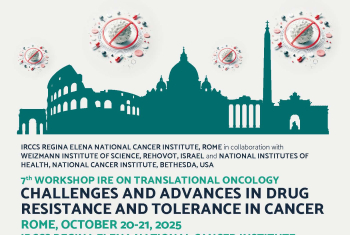
7th Workshop IRE on Transnlational Oncology: "Challenges and Advances in Drug Resistance and Tolerance in Cancer"
Rome, October 20-21, 2025
Register here
Overview:Resilience to anticancer drugs is an increasingly critical challenge in precision oncology. Over time, cancer cells can develop drug resistance or tolerance, significantly impacting therapy outcomes. The multifactorial mechanisms underlying tolerance, resistance, and persistence are being actively investigated, highlighting the urgent need to bridge research from the bench to the clinic—and back again. Addressing the intricate interplay between cellular evolution, metabolism, and plasticity is essential to overcoming therapy resistance. A deeper understanding of these mechanisms holds the promise of developing novel therapeutic strategies that are less susceptible to drug resistance. It also advances our knowledge of both genetic and non-genetic factors driving resistance and tolerance. This workshop will bring together leading experts in therapeutic resistance, fostering an interactive environment where senior and junior scientists, as well as clinicians, can exchange the latest breakthroughs. Discussions will focus on the mechanisms underlying drug resistance, the phenotypic trajectories of resistant cells, and the role of the tumor microenvironment in resistance and tolerance. Through insights from cancer biology, translational research, and clinical studies, this workshop will showcase cutting-edge advances in understanding cellular adaptation to anticancer drugs. By unraveling these complexities, we aim to pave the way
for more effective cancer therapies that can ultimately improve patient outcomes.
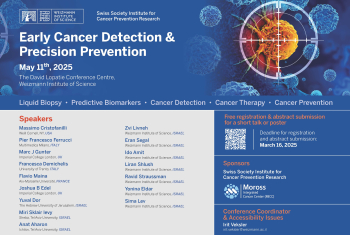
The SSICPR's Early Cancer Detection & Precision Prevention meeting was held on May 11th 2025.
Excellent national and international speakers participated. We look forward to many more successful meetings to come. The full program can be viewed here: Full Program

The most common and deadliest type of ovarian cancer is high-grade serous ovarian cancer (HGSC). A study co-authored by Prof. Moshe Oren of the Department of Molecular Cell Biology—in collaboration with colleagues from the University of Pennsylvania and elsewhere—reveals the identification of an early event in the development of this disease. The scientists found that the loss of a molecule called RNF20 promotes the expression of IL6, a protein that plays a part in the migratory capacity of aggressive cancers. These findings may eventually contribute to novel strategies for the early diagnosis of high-grade serous ovarian cancer.
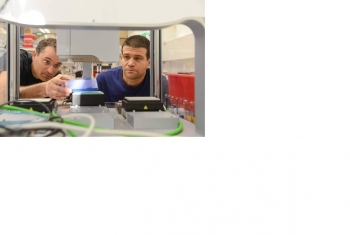
A major challenge facing multiple myeloma patients and their physicians is that the disease often persists in a pre-cancerous stage for an indeterminable time. Now, the Immunology Department’s Prof. Ido Amit, together with Prof. Amos Tanay of the Department of Computer Science and Applied Mathematics, has developed a “Big Data” method that makes it possible to use single-cell RNA sequencing of blood and bone marrow to identify a very small number of malignant cells in multiple myeloma’s pre-malignant stage. The researchers anticipate that this technique will lead to improved diagnosis of sub-populations of patients, allowing physicians to target aggressive care to those patients at highest risk, while reducing unneeded treatment for low-risk patients.
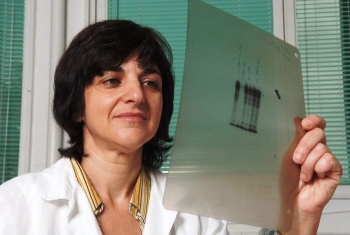
Prof. Rivka Dikstein of the Department of Biomolecular Sciences recently demonstrated how a mutation that affects mRNA translation “sets the stage” for cancer. Using mammalian cells, she showed that an initiation factor called elF1A—known, in its mutated form, to be associated with cancers of the ovaries, thyroid, and eye—plays a critical role in maintaining both cell cycle progression and cell proliferation. Prof. Dikstein’s study reveals that this initiation factor is an essential component of an inhibitory feedback loop that blocks the overexpression of proteins, thereby controlling molecular dynamics that can trigger cancer onset. Her work reveals eIF1A as a biomarker that may eventually contribute to new protocols for preventative cancer screening, as well as diagnosis and personalized cancer therapy.

Dendritic cells (DCs) are a special population of cells within the immune system. A team headed by Prof. Lea Eisenbach of the Department of Immunology recently used genetic techniques to edit out part of the native DC surface, replacing it with a peptide sequence based on melanoma antigens. When administered into cancer bearing mice, these customized immune cells were able to inhibit tumor growth, and improve mouse survival. This method could potentially be applied to many different tumor types.

Autophagy is a regulated destructive mechanism that disassembles a cell’s unnecessary or dysfunctional components. Prof. Adi Kimchi of the Department of Molecular Genetics and her colleagues recently took a “Big Data” approach to identifying autophagy-related mutations. She screened public databases of health records, identifying a microtubule-associated mutation that was detected in early stages of the development of primary tumors. The presence of this mutation—which prevented the completion of protein interactions required for autophagy—could serve as a marker for identifying individuals at high risk for cancer onset.

The build-up of senescent cells—cells that stop dividing, but do not die—is a hallmark of aging tissues as well as cancer. Prof. Valery Krizhanovsky has helped clarify how senescence, known to block the proliferation of premalignant cells, can also promote tumor growth and progression. Studying premalignant pancreatic lesions, he demonstrated that senescent cells within such tumors exhibit high levels of a protein called Cox2. Further, he showed that pharmacologic inhibition of this protein prevented the lesions from progressing and becoming pancreatic carcinoma. These findings indicate that targeted elimination of senescent cells may be effective in limiting progression of precancerous lesions, and serve as an effective strategy for cancer prevention.

Until now, most individuals referred to early CT screening for lung cancer have been smokers. Prof. Zvi Livneh and his colleagues are exploring a different approach, examining the efficacy of determining lung cancer risk through an individual’s “DNA repair score”—a summation of the activity of a number of molecular pathways through which cells are known to respond to genetic damage, as revealed in a blood test. Prof. Livneh’s study confirmed that a low DNA repair score indicates a heightened risk for lung cancer, regardless of the case’s disease stage. This may significantly improve current standards for identifying individuals who are candidates for early lung cancer screening.
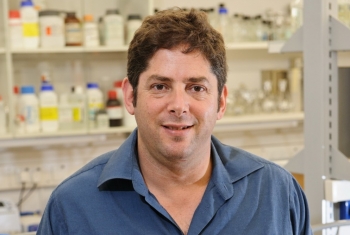
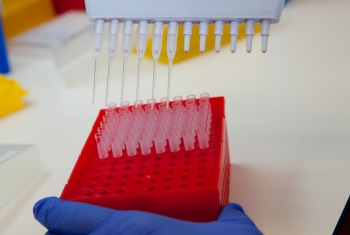
Single-cell genomics is a powerful tool with the potential to generate insights that can dramatically improve treatment results for cancer patients. In single-cell genomics, different cell populations are separated prior to sequencing–something that makes it possible to determine whether immune cell populations are affected by immunotherapeutic treatment.
Dr. Itay Tirosh, a member of the Department of Molecular Cell Biology, is a computational systems biologist who is enhancing the range of medically-significant data that can be derived through the use of single-cell genomic techniques. Specifically, he has pioneered the application of single-cell RNA-sequencing to solid human tumors in melanoma and glioblastoma—an aggressive form of brain cancer. His advances are making it possible to better characterize complex interactions between heterogeneous populations of cancer cells within tumors on the one hand, and diverse type of immune cells on the other. Dr. Tirosh’s work is contributing to advances in personalized medicine, an approach that will someday give doctors the data needed to match the best treatment to each individual cancer patient.
Dr. Tirosh, who completed both his MSc and PhD at the Weizmann Institute, returned to campus to join the faculty after completing postdoctoral research at the Broad Institute of MIT and Harvard.
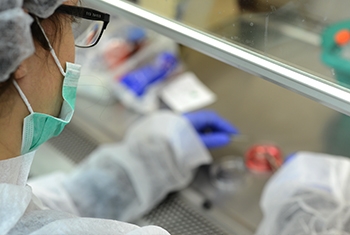
The Weizmann-Brazil Tumor Bank allows scientists to establish models in which tumors, freshly obtained from patients in the operating room after biopsy or tumor resection, are implanted directly under the skin of genetically engineered animal models in a procedure known as patient-derived xenografts (PDX).
These tumors, which resemble to the greatest possible extent the original tumor growing within the human patient, can then be transferred from the first animal model to additional specimens, eventually propagating the tumors into a large colony - all bearing the same human tumor. This colony provides the researchers with a unique opportunity to perform a large variety of experimental manipulations, in parallel on identical replicas of the original tumor. These manipulations enable the identification of critical genes whose targeting can stop tumor growth or even kill the tumor.
The work of Prof. Yardena Samuels has already yielded four new PDX mouse strains, and it is hoped that this synergy between the two facilities will generate more use of PDX mice for basic cancer research.
Picture (left): Preparation of a tumor sample extracted from a PDX mouse, prior to implantation into additional animal models.
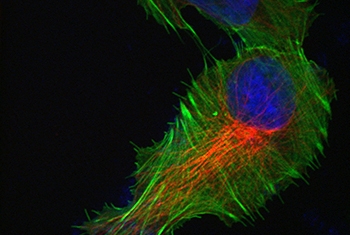
The green, red and blue seen here is the result of an immunostaining technique that reveals modification in cell structure in response to growth factor stimulation. The treatment of a non-cancerous epithelial breast cell line with a growth factor induced motility, leading to the modification and reorganization of the cytoskeleton. This technique, which reveals the presence and position of actin (green), tubulin (red) and the cell nucleus (blue) in non-cancerous cells, enables the visualization of pathways and conformational changes associated with cancer.
The cells were grown on matrix coated glass. The staining was performed through the use of probes for the nucleus (DAPI) and actin (phalloidin),and, for tubulin, with an immunostaining antibody. The images were taken using a spinning disk microscope.
Image curtesy of Lee Roth, Prof. Yosef Yarden lab
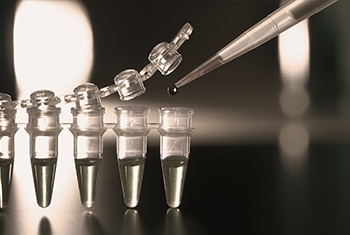
The Kleinman Cancer Cell Sorting Facility provides state of the art instrumentation for the study of cancer cells at single cell resolution. Below we highlight some of the recent advances of Weizmann teams using these approaches.
Flow cytometry, the key approach of the Kleinman Cancer Cell Sorting Facility, is a laser based technology in which individual cells are discriminated from each other using surface markers that are 'read' with the help of specific detection reagents - the so-called monoclonal antibodies. This method allows for the analysis of single cell mixtures by passing them in front of a dye-detector at a speed of a thousand cells per second. Moreover, beyond their identification, individual cells can be sorted for subsequent functional assays, as well as molecular analysis, including transcriptome and epigenome profiling.
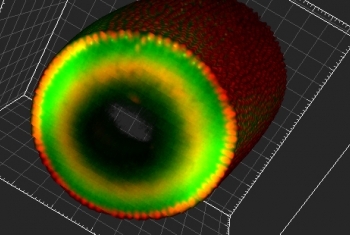
This is a visualization of transcription dynamics in a live Drosophila fly embryo under Lightsheet microscope.
The nuclei appear in red and the active transcription of the gene snail is detected by the MS2 system resulting in a fluorescent signal. In other words, the green dots inside the nuclei mark the intensity of gene expression.
This tool enables us to study transcription dynamics in a quantitative manner.
Courtesy of Neta Strasser-Rahimi, Benny Shilo lab.


By combining the power of high throughput flow-cytometry with a microscope, Image Stream analysis complements the analysis of cell surface markers with critical information on the inside of cells. In the figure shown below from Moshe Oren’s group, distinct localization patterns of mitochondria within cancer cells are depicted. In blue we see the nucleus of the cells, and in green and red inactive and active mitochondria, which reside within the cytoplasm.


Based on the established role of mutations in cancer, and the importance of oxidative stress in creating the environment in which mutations occur, Prof. Zvi Livneh and Dr. Tamar Paz-Elizurof the Department of Biomolecular Sciences are exploring the role that non-optimal repair of oxidative DNA damage plays in colorectal and breast cancer onset. Using an integrated approach that combines epidemiological and clinical studies, the researchers have created a unique set of DNA repair blood tests that help characterize the molecular environment, and correlate this data with known risk factors for breast and colorectal cancer. Using this approach, they hope to lay the groundwork for early detection strategies.
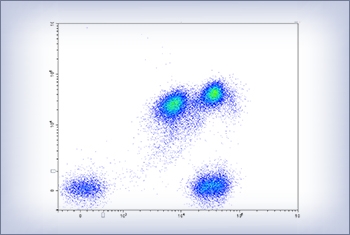
Flow cytometry is a crucial tool for the analysis and diagnosis of blood cell malignancies. Specifically, this technology enabled the Shlush group to detect rare cells that harbor pre-leukemic mutations. The figure (left), made by Amos Tuval, illustrates the cell sorting approach and highlights the discrimination of single cells, which appear as single dots on the two dimensional plot.

Cell membranes and nuclei of different growth plate zones.
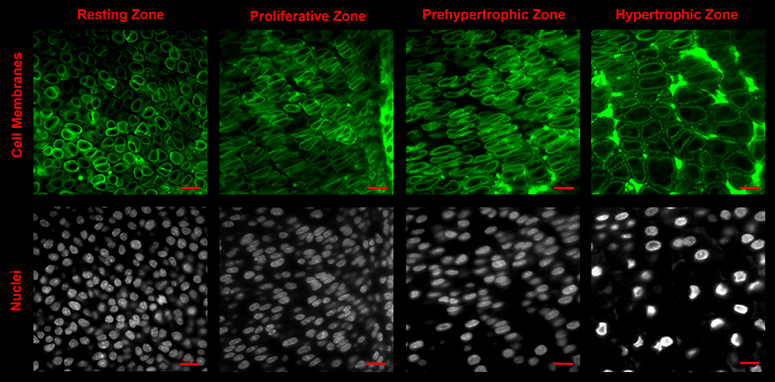
Courtesy of Sarah Rubin, Eli Zelzer's lab

Spring school for advanced imaging in biological research was a conference that took place at the Weizmann Institute of Science, on March 15th-16th.
Advanced imaging techniques are becoming increasingly important in life sciences, biological studies and medicine. Technologies span over a wide range, from standard optical microscopy to advanced multiphoton and light sheet imaging, and from magnetic resonance imaging (MRI) to matrix-assisted laser desorption ionization (MALDI).These are very diverse techniques, based on different principles, each isolating a different type of signal or properties. The use of various contrast sources enables aquisition of specific knowledge about an organ, cellular subpopulation or extracellular matrix, providing information about structural features, chemical composition and other characteristics.
During the last decade, resecarhers have combined several methods in order to achieve deeper understanding of live organisms at the cellular and molecular level, for diagnostics and disease modeling - and for the development of novel drugs.
The combination of high spatio-temporal resolution, speed and sensitivity as well as robustness, make today's advanced imaging tools indispensable.
The aim of our school was to maximize the synergy that can be achieved through the use of many research approaches incorporating different disciplines in advanced imaging, as preseted by experts who are world leaders in their fields.

The new two-photon microscope at the de Picciotto-Lesser Cancer Cell Observatory is a powerful tool, which is able to accommodate imaging in human tissue. It serves in the study of a few aspects of cancer, for example, the study of spheroids - 3D cell cultures that are cultivated in vitro to resemble a living tumor.
This system allows deep, live imaging of up to a 1 mm thickness, and is based in infrared excitation of fluorescent dyes. This method results in a miniscule amount of excitation, in contrast to confocal or wide-field microscopes, and therefore prevents bleaching or other photo-damage to the tissue. The excitation process uses a special titanium-sapphire pulsed laser, with very brief peaks of excitation and very high peak power.
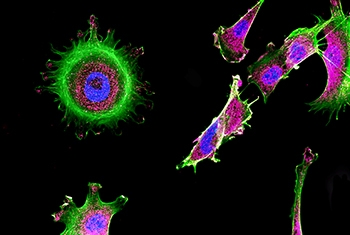
On December 7th, 2016, the Swiss Society Institute for Cancer Prevention Research, a division of the Moross Integrated Cancer Center (MICC) at the Weizmann Institute of Science hosted a talk by Prof. Avrum Spira. Prof. Spira, Director of the Boston Medical Center Cancer Center of Boston University, spoke about “the airway transcriptome as a biomarker for lung cancer detection and prevention.” In his lecture, Prof. Spira described techniques he and his team have developed for the identification of gene-expression-based biomarkers that can contribute to the personalized care of patients with lung cancer, as well as chronic obstructive pulmonary disease (COPD).
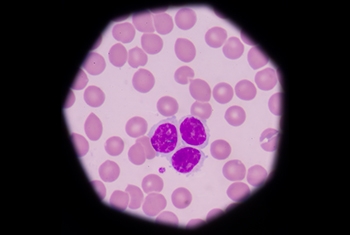
Lymphocytes are cells in our immune system that work as sentinels, identifying and eliminating flawed cells, including those that have been transformed into a pre-cancerous state. Researchers at the Swiss Society Institute for Cancer Prevention Research are examining new avenues towards the characterization of this “surveillance” function, in order to eventually adopt this functionality in preventative therapeutics for high-risk patients.
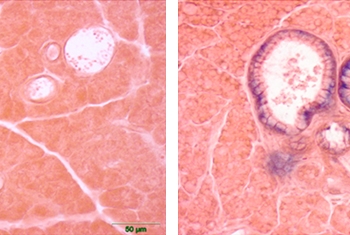
When the body identifies flawed cells, programmed cell death kicks in and prevents their proliferation. Dysregulationof this process–also called apoptosis–can lead to cancer onset. Dr. Valery Krizhanovsky, of the Department of Molecular Cell Biology, is examining one apoptotic process called senescence, in which flawed cells are left to live, but cannot proliferate. While a senescent state, which can occur in response to cancer-inducing mutations, serves as an initial barrier to tumor development, the presence of non-dividing, senescent cells is also linked to inflammation, tissue destruction, tumorigenesis and metastasis. Using a small molecule, Dr. Krizhanovsky has demonstrated that it is possible to target and trigger apoptosis in senescent cells. Working in a model of pancreatic cancer, his team’s work is contributing to new strategies that may eliminate senescent cells, and thus prevent the progress of pancreatic cancer to its more advanced stages.
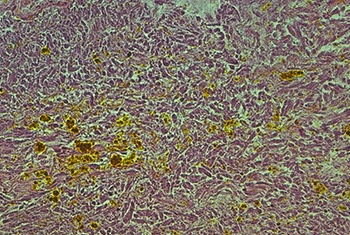
The Weizmann-Brazil Tumor Bank receives tissues from biopsied tumors or tumors removed from patients through the cooperation of various medical centers. The images below are examples of human melanoma tissue samples received from Hadassah Medical Center in Jerusalem.
Generally, the samples received are divided into small pieces; some are implanted into immunodeficient mice, and the rest are stored for future use.
Most of the stored samples are kept in the “biobank”, i.e., a -80°C freezer, while a small amount is preserved in formaldehyde, and then processed into paraffin blocks. The scientists cut the blocks into thin slices (6 μm) in order to allow histologic examination of tissue morphology, genes, vessels, etc.
The sample shown above is from a metastatic melanoma tumor, also known as stage IV melanoma (when cancer cells have spread to other organs). It portrays the tumor cells variability in size, shape, and staining (pleomorphism), as well as the presence of melanocytes (scale bar indicated).


Extensive studies have established a causal link between smoking and cancer. While the danger of smoking is now well known, the general public is less aware of cancer-related risk factors stemming from air pollution. This is one area of research being pursued by Prof. Yinon Rudich of the Department of Earth and Planetary Sciences.
An expert on the physical and optical properties of aerosols—the airborne dust that contributes to the onset of cancer as well as other disease conditions—Prof. Rudich has demonstrated how exposure to suspended urban dust can reduce the body’s natural antioxidant response and increase lung cancer risk. His research is clarifying how such exposure alters gene transcription in specific genetic networks, thus identifying “biomarkers” that can be used to quantify cancer risk. As such, his work is clarifying the factors that will drive the creation of more informed environmental policy—and better health—in the future.
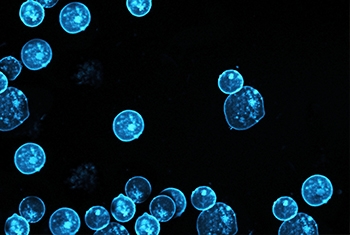
Dr. Liran Shlush,of the Department of Immunology, combines single cell technologies, advanced sequencing technologies, and stem cell biology while trying to understand what triggers the evolution of leukemia in its earliest stages, in order to advance early diagnosis and treatment of this disease.
One recent study by Dr. Shlush aims to define novel concepts in somatic evolution. Cancer is the end product of somatic evolution, where cells acquire mutations over time and change their phenotypes. While classic evolution is focused on genetic changes to DNA, Dr. Shlush hypothesized that in the short period of leukemia evolution, the mutation rates are too low to account for the massive phenotypic diversity. Accordingly, Dr. Shlush and his team are exploring the epigenome and RNA as evolutionary units. For the first time, they have evidence that mature, old red blood cells (RBC) include RNA, despite not having a nucleus or DNA. Their RNA could be stable, replicated from an RNA template, or absorbed from the environment. In any case, these findings suggest that RNA can serve as an evolutionary unit that can shape somatic evolution. They are also studying, in collaboration with the lab of Prof. Amos Tanay in the Department of Computer Science and Applied Mathematics, the rate of epigenetic mutations in these cells to see whether changes in methylation can shape somatic evolution in preleukemic cells.
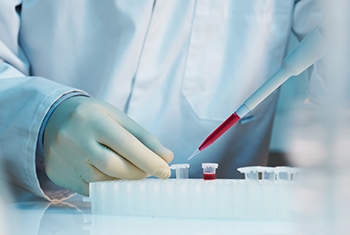
Prof. Tsvee Lapidot of the Department of Immunologyis working with a colleague at MD Anderson Cancer Center in Houston, seeking to develop an innovative method for improved engraftment of blood stem cells, which, it is hoped, will accelerate the recovery of patients with high-risk hematologic diseases who are undergoing blood cell transplantation.

This movie shows a proximal tibial growth plate: red indicates muscles and blood vessels, and green indicates the cartilage.
Courtesy of Sarah Rubin, Eli Zelzer lab
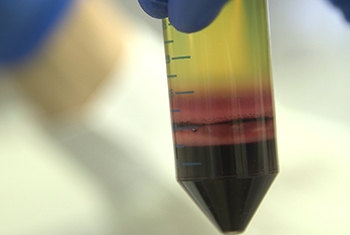
Translational research is essential in moving basic research discoveries from the lab to the public health arena, and tissue samplesare a necessary and precious resource for these studies.
Blood is a common tissue often used in translational and medical research. Peripheral Blood Mononuclear Cells or PBMC (composed primarily of lymphocytes) are isolated by fractionation in Ficoll tubes.
The images below show a blood sample invacutainer tubes before centrifugation (left), and a blood sample in a Ficoll tube after centrifugation (right).
The centrifugation processresults in the isolation of the PBMC band. Through the use of robot-assisted tests developed in the lab of Prof. Zvi Livneh, these cells are utilized for the measurement of DNA repair enzyme activities.


Prof. Varda Rotter of the Department of Molecular Cell Biology and colleagues at Tel Aviv Sourasky Medical Center are looking into novel methods to target p53 mutations in glioblastoma, a particularly deadly brain cancer that is in great need of effective medical treatments.

